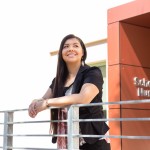By Lilian Min
LA Weekly, January 24, 2017 —

Anti-war march in 1972. Asian Pacific American Photographic Collection, Visual Communications Archives
On Saturday, Jan. 21, hundreds of thousands of people spilled into downtown Los Angeles to protest a president whose promise to “make America great again” threatens to turn back the clock on civil liberties at least several decades for marginalized groups.
Coincidentally, just two days earlier, the Chinese American Museum opened “Roots: Asian-American Movements in Los Angeles 1968-80s,” an exhibit that digs into an oft-overlooked historical resistance, which can inform how we build new activist coalitions for the future.
The Asian-American movement was the first broad, pan-Asian diaspora coalition in America. Within it, activists rallied around causes that ranged from the war in Vietnam to the eviction of elderly, non-English-speaking residents within gentrifying communities to youth drug abuse. They boosted socially conscious films and music by Asian-American artists, joining a groundswell of movements that included the civil rights movement, the Chicano movement, second-wave feminism and the gay liberation movement. “Roots” is an effort to contextualize the many causes at work during this era while specifically centering L.A.’s Asian-American activism and identity formation — a mighty task, considering that Asia is a vast continent with individually and regionally complicated histories.
“This idea of Asian America didn’t exist until 1968, and it’s really the work of people in their 20s, even teenagers, coming together and producing culture, making institutions, working on campaigns, that defined this identity. It’s pretty remarkable to think about how Asian-American is a term all of us use now, but it was really created and invented by dedicated young people,” Ryan Wong, who curated the exhibit over the course of years, said over the phone. Wong had previously put together the show “Serve the People: The Asian-American Movement in New York” in NYC’s Interference Archive space.
That show ran from late 2013 into early 2014, and it was during this time that CAM curator Steve Wong (no relation) first entertained the notion of bringing a similar show to L.A. Though the exhibit is hosted at CAM for the next six months, Ryan Wong is quick to point out that this was for the space’s community-oriented mission, rather than a move to, say, center Chinese-American activism: “A really important and significant step for any kind of identity-focused museum is to recognize these common points of intersection and overlap.”

Alan Ohashi, Courtesy Visual Communications
he task of centering Asian-American identity in Los Angeles is extra difficult. The city’s Asian ethnic enclaves include Little Tokyo, Chinatown, Koreatown, Historic Filipinotown, Little Bangladesh, with larger communities in the surrounding area. “Roots” makes a sincere effort to include as many intersections of Asian-American identity as possible, but part of the problem is that inter-Asian conflicts abound. Yet as Steve Wong explained in a tour of the exhibit, “Back then, because of strict Asian immigrant laws, most Asian-Americans were second-gen[eration], third-gen, and didn’t have the same opinions about other Asians that their parents might have.” Combined with both the recent past of Japanese internment and the vicious war in Vietnam, young Asian-Americans began to formulate explicitly political identities. One of the photographs on display, of an anti-war protest, features someone marching with the sign “Viet Cong don’t call me a fat chink.” Activists, generally young and often college-educated, mobilized to defend their immigrant elders and challenge what they saw as an imperialist war against both Vietnam and the Third World as a whole — it was part of a larger critique of Western militarization and colonialism.
As we’ve seen in the past year, public memory about the struggles of civil rights activists of all causes is incredibly shoddy. When a Trump supporter raised Japanese internment as a precedent for a new Muslim registry, what surprised me more were the stories people shared of never having been taught about internment in basic U.S. curriculum, or about any sort of Asian-American political activity. It is into this information void that the Asian-American movement has slipped; many of the organizations behind the movement, like JACS-AI (Japanese American Community Services-Asian Involvement) and the Amerasia Bookstore in Little Tokyo, and the Asian-American Tutorial Project (centered in Castelar Elementary School in Chinatown) no longer exist, though others like SIPA (Search to Involve Pilipino Americans) and Visual Communications (which was home to the first Asian-American filmmakers) do. This lack of available activist history then contributes to pervasive stereotypes that Asian-Americans are apolitical model minorities, aligning themselves to a white, heteropatriarchal status quo.
The full legacy of these movements, Asian-American and otherwise, seems to have been compartmentalized into narrow academic strata. Steve Wong received his education through UCLA’s groundbreaking Asian-American Studies department, but like African-American Studies, Women’s and Gender Studies and Chicana/o Studies, the Asian-American movement’s legacy of activism and organizing is lost to most of the general population — Asian-Americans

Police and protesters in downtown L.A. Courtesy CAM
What “Roots” showcases well is the breadth and reach of the movement’s efforts: Old copies of Gidra Magazine, which was started in and centered at UCLA but circulated across the country, detail many of the same issues we face now. The Chinatown Education Project’s family newsletter included English, Chinese and Spanish text to reach out to the area’s heterogeneous population. And the show’s name comes from the landmark UCLA Asian-American Studies textbook, published in 1971, which became both a foundational text and a reference for young activists.
These artifacts, many of them in the form of fragile paper posters, newsletters, magazines and prints, alongside music by singers like Chris Iijima and Charlie Chin and a loop of Visual Communications–produced films, were painstakingly curated from archives, museum collections and personal collections. But it was through oral histories from now-elders of the movement that Ryan Wong first became interested in this part of Asian-American history; “Roots” is necessarily formed through personal narratives like that of Yvonne Wong Nishio, whose speech for the 1977 International Working Women’s Day (the first and only one) remains fiercely relevant today. The result is an exhibit that knows it’s limited — by its material, by the void it’s trying to redress, by the spread of its interests — but leaves viewers wanting more.
CAM’s opening reception for “Roots” drew more than 700 people: activists of yore reflecting on their contributions (both then and literally on the walls) and communities, but also many young people who came to seek out a history that has largely been elided over in their educations. These are the people that Steve and Ryan are seeking out. The latter Wong knows this can happen because that was the impetus behind his research and curation, and hopes that what “Roots” does is give activists now a new foundation upon which to stand: “That’s a really important lesson for this moment: If you believe that history is made by presidents, then it’s really easy to despair. But, in fact, by looking back at this history, history is really made by communities, it’s made on the person-to-person level, it’s made by people organizing, by creating arts. … To remember that what you’re doing as an Asian-American activist isn’t in isolation but actually comes in this lineage.”

“Roots: Asian American Movements in L.A. 1968-80s,” Chinese American Museum, 425 N. Los Angeles St., downtown; through June 11. camla.org.











